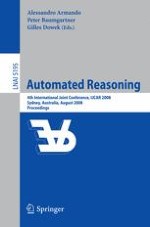This book constitutes the refereed proceedings of the 4th International Joint Conference on Automated Reasoning, IJCAR 2008, held in Sydney, Australia, in August 2008. The 26 revised full research papers and 13 revised system descriptions presented together with 4 invited papers and a summary of the CASC-J4 systems competition were carefully reviewed and selected from 80 full paper and 17 system description submissions. The papers address the entire spectrum of research in automated reasoning and are organized in topical sections on specific theories, automated verification, protocol verification, system descriptions, modal logics, description logics, equational theories, theorem proving, CASC, the 4th IJCAR ATP system competition, logical frameworks, and tree automata.
